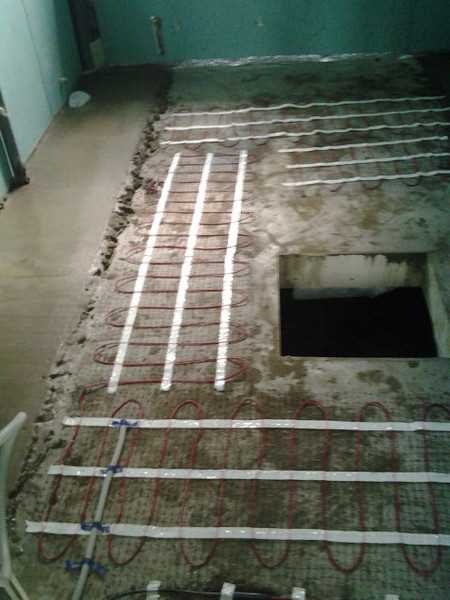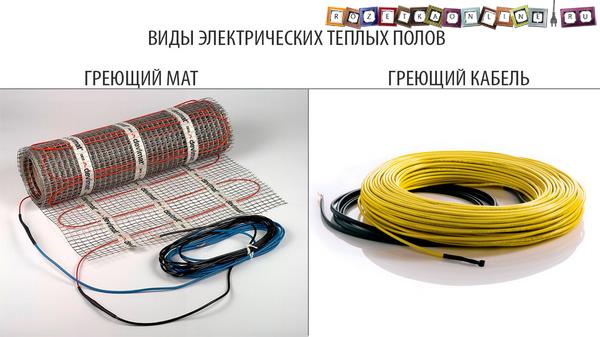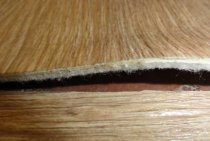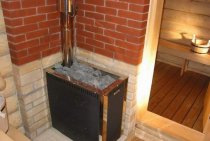Underfloor heating problems
A malfunction of an infrared underfloor heating system is an unlikely but possible event. The most common reason for this is a mistake made during installation. In this article, we will look at ways to find the cause of a malfunction.
First of all, it is necessary to determine the faulty element. The main elements that can be incorrectly connected or fail are the heating element itself, connecting wires, a thermostat and temperature sensors.
The main elements of the underfloor heating system
Make sure the thermostat is powered up and set to the correct settings. If power is applied but there is no effect, the next step is to check that the wires to the thermostat are connected correctly. Refer to the instruction manual or the pin markings on the back of the thermostat and make sure all pins are connected correctly. If everything is in order here, then we proceed to check the heating elements themselves.
In most cases, the heating film fails due to unskilled installation. This may be an error in connecting the wires to the film, their kink during installation, or an incorrectly calculated cross section.
There are two ways to check the health of the heating film.
Resistance measurement
The first way is to measure the floor resistance and compare it with that indicated in the passport. The resistance value can be calculated using the formula R=U/P. When using several heating elements, you can check the resistance of each separately.
Signs of a defective film underfloor heating:
- If the meter reading is zero, most likely a short circuit has occurred in the system.
- If the reading of the device is equal to infinity, the heating element may break in the system.
In any case, if the measured resistance does not match the passport one, the cause of the malfunction lies in the film. It is necessary to check the integrity of the wires and the correctness of their connection to the heating elements.
Heating film connection
The second way is to connect the power to the warm floor directly, bypassing the thermostat. If the film starts to heat up, then the problem is in the thermostat. Otherwise, it is necessary to check the film and the wires connected to it.
Attention!
All work is carried out with the power off! The contacts on the thermostat may differ, follow the instruction manual and the marking on the thermostat.
Connecting the film to the network without a thermostat for a long time can lead to its failure. If, when connecting the heating film, the machine directly knocks out, a short circuit or malfunction of the machine is possible, in this case it is necessary to measure the resistance of the warm floor, it should not tend to zero.
How to check the operation of the thermostat
Thermostat malfunctions can be associated both with the device itself and with an external temperature sensor.
When the thermostat fails, most often the relay or capacitor is to blame. Given the cost of repairing it, it is more advisable to purchase a new thermostat. To check the performance of the thermostat, you must:
- set the minimum temperature on the thermostat,
- apply voltage to the thermostat and measure it (should be 220 V),
- move the toggle switch to the ON position,
- set the maximum temperature on the thermostat. When the temperature rises, a click is heard at a working thermostat (the relay switches). The voltage at the load contacts (wires going to the heating elements) should be 220 V.
- when the thermostat is set to the minimum temperature, the relay is activated again, turning off the voltage supply to the load contacts.
Checking the temperature measurement sensor
To check the health of the floor temperature sensor, it is necessary to measure its resistance with a multimeter. Each sensor has a declared factory resistance, indicated in the passport. As the temperature sensor heats up, its resistance decreases. If the resistance differs by more than 5 kOhm, or is equal to 0, then the sensor is faulty and needs to be replaced.
Note
In programmable thermostats, if the temperature sensor fails, a corresponding message is displayed on the panel.
Expert answers
Sergey Popov:
In no case. The foreman is clearly scamming you. The warm floor heats up immediately. If the floor is electric, then the circuit is broken or the regulator does not work.
Agonda:
Heated floors are different. Electric immediately starts to heat. Water longer. We have a large area (the entire first floor, about 100 sq. M. ) The heated water floor turned on for the first time was heated for a day. And that's a lot. Fraudster your foreman or clumsy. Most likely, he screwed up, now he is thinking how to shake off and dump. I don't want to fix it myself...
Evolutionary:
Well, about the moisture, he turned it down. What floor do you have (cable or mat)? If the cable is in a tie, then it can really heat up for a long time. And check: you can disconnect the wires of the floor itself from the thermostat and measure the resistance with a tester or by email. counter. Turn off all email. appliances, and then turn on the floor el. the counter should begin to "twist".
Andrey:
The foreman claims that to check the correctness of the work, you need to wait a month, says that there is still moisture under the tile and it interferes with heating .... you need to trust people, we don’t live in the forest, support this holy man and tell me what prevents not only heating, but also paying for all his work, after all, he himself suggested waiting a month, so go towards this unconditionally honest person ....
Winds:
I support Andrey. Offer to either fix the problem or get money when the floor works.
Any electrical appliance emits heat - if it works, regardless of humidity. And if the foreman himself said that he laid the cable on a damp base or laminate on a wet bulk - demand money from him for damaged materials - a violation of technology
Dmitry Ostankov:
You need to check two indicators: 1) the resistance of the heating core of the mat (using a multimeter). It must correspond to that specified in the passport for the product. permissible deviations: +10% / -5% of the specified indicator. The terminals of the multimeter are connected to the terminals of the heating wire at both ends. 2) insulation resistance (using a megohmmeter). Between the terminals of the heating wire at both ends of the mat, the megohmmeter should show “0”, i.e. short circuit. , since these veins are closed. Between any of the cores and the screen, the device should show "infinity" - "8" on its side. This is the main indicator. It indicates the integrity of the mat insulation. This indicator is especially important after pouring. And do not believe the electricians who only checked the resistance with a Chinese tester and say that everything is in order.
Andrey Volkov:
They check it in the store with you, upon purchase. - they look at the resistance with the device. 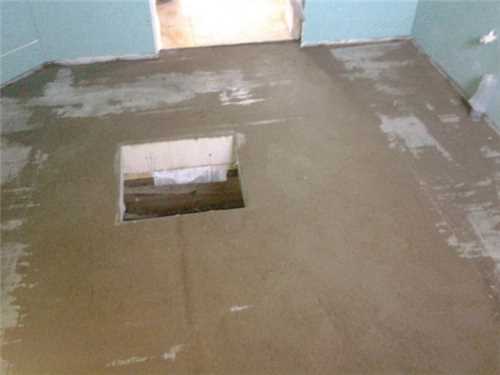
Alexander Bakushev:
You can turn it on for a few seconds, if it gets warmer, then it's working!
Stas Shabanov:
Check with a tester, it should show 60-70 ohms ..
HEATED FLOOR POWER PER SQUARE METER
Regardless of whether mats or cable - a warm floor is usually chosen so that for each square meter of heated surface there is, on average, 150 W of electrical power. Depending on the purpose of the room and the purpose of the installation, this value may vary:
- from 100 - 130 W, when it is enough just to make the temperature of the coating on the surface comfortable, for example, on the floor bathroom tiles or in the kitchen
- from 130-180 W, when it is necessary to supplement the main heating system, it is used most often. It can heat the flooring quite strongly, thereby additionally heating the room during cold periods;
- from 180 - 250 W, when the warm floor is used as the main source of heating, or, is a full-fledged part in the general heating system for places where it is especially cold, for example, a balcony;
- On average, the power of a running meter of a heating cable for underfloor heating is 10 - 20 W / m.p .;
Thus, after measuring the resistance, you should estimate the approximate installation area and proceed with the calculations:
Example: Let's say you have a corridor in an apartment in which about 6 square meters are heated. By measuring the resistance of the heating cable with a multimeter, you got a result of 55 ohms. It remains to calculate how much this is enough for such an area:
First of all, we determine the total power:
P=U2/R= 220 2/55 = 880 W
Then the power of 1 square meter:
Pkv.m. \u003d 880/6 \u003d 146.7 W / m.kv. - which, taking into account the error, corresponds to the standard, most common electric floor heating power. If the calculated value is too low or high - then you will understand that it is the heating cable that is the cause of the malfunction - and you can fix it.
As you can see, measuring the resistance of an electric underfloor heating cable is the main diagnostic method. Heating mats or cable, after they are installed in a screed or tile adhesive, cannot be removed and inspected without complete dismantling. And to measure its resistance with a multimeter in everyday life is available to everyone and is not an impossible task. Knowing that the floor conductors are not broken, do not short and have enough power to heat up - you can continue to look for the cause of the malfunction in other components.
The method of checking the underfloor heating for performance
To determine the malfunction of the heating system, two methods can be used: visual and the method of measuring the main parameters. And if in the first case the consumer can start only from external signs (blackening, insulation melts, etc.), then the second option gives a more accurate assessment of the damage to the system.
Checking underfloor heating with a multimeter
The first step is to make sure that there is a supply voltage at the thermostat terminals. Why by transferring the multimeter to the position for measuring AC voltage, you need to make sure that the network is available. You must first remove the protective cover from the temperature controller.
The next step is to measure the resistance of the heating cable (film). For which the entire system should be de-energized and, having switched the multimeter to the position for measuring resistance, attach the probes of the device to the terminals of the heating elements (after disconnecting them from the thermostat terminals).
Resistance values may vary depending on the power of the device. Well, in order to accurately determine the correctness of the measurements (knowing the power of your warm floor), you can use the following relationship:
P=U2/R,
And then, substituting the available values, you can determine the correctness of the measurements.
For example, if the multimeter showed a resistance value of 100 ohms, then the power of your warm floor according to the above formula will be P=2202/50=480W.
By the way, if there are no passport data for a warm floor, then on average you can take the power of the heaters in the ratio of 150W per 1 square meter of floor area.
By comparing the measurement results with the existing characteristics, it will be possible to find out about the quality of the heater. If the measurement results differ significantly from the passport data (more than 10 - 15%), then we can talk about damage to the heating element.
Excess resistance - short circuit;
Reduced (zero) resistance indicators - cable break.
Of course, further repair of the underfloor heating will require the involvement of specialists for the dismantling and subsequent installation of heating elements.
Thermistor test
In the case when the heaters are intact, the next thing to pay attention to is the thermistor. Its integrity can also be checked with a multimeter.
However, it should be understood that the value of electrical resistance for a given element can vary significantly depending on the ambient temperature. And the same sensor will show 20kΩ or more at t= +5⁰С and 5kΩ at t= +35⁰С. At this point, you should pay attention and additionally check the process of changing the resistance when the temperature sensor is heated.
As mentioned above, replacing the thermistor is a very simple event. And if necessary, the consumer will be able to perform the specified procedure independently.
Cable constructions and arrangement
According to the principle of operation, the cable in the design of a warm floor can be:
- self-regulating;
- resistive.
A self-regulating cable in operating mode changes its resistance with temperature changes. The resistance value of a resistive cable does not depend on temperature. If the cable installation work is carried out in compliance with all requirements and recommendations, then the cable will not be damaged by temperature. The main requirement for laying the cable is to withstand a certain length. If the cable is long during laying, it must not be shortened, as this will cause a change in current characteristics and heating, which will lead to the destruction of the insulation. In practice, 2 types of heating cable are most often used:
- single two-wire;
- 2 single-core with a parallel arrangement.
A single two-core cable is a mesh of wire, muffled on one side. Mount such a cable in a concrete screed. The selection of the grid is carried out strictly according to the area of \u200b\u200bthe room, free from plumbing and furniture, since it cannot be cut.
The parallel arrangement of 2 separate cable cores is also mounted in a screed, but differs from the previous cable in that its length can be changed without fear for insulation.
The film floor based on infrared heating differs from cable structures in that it is a chain of active resistances. The advantage of the film in its small thickness and the possibility of using with almost all floor coverings. It is allowed to change the area of the film, but only according to special marking marks.
What should be the resistance of an electric underfloor heating
Underfloor heating is most often produced in the form of a heating cable or mats:
Heating mats are a heating cable laid in a certain way and fixed in this position. In addition to the fact that this option has a much simpler installation, it has a fixed power per square meter, which does not change.
But the power of a square meter of a floor made with an ordinary cable can vary greatly, depending on how it is placed on the surface, with what density, how many turns are made and what is the distance between them.
If you know what power the kit is, by measuring its resistance, it will not be difficult for you to check its serviceability and efficiency:
It is enough to use Ohm's law, namely the following formula:
P=U2/R, where P, Watt – power; U, Volt - mains voltage, usually 220 Volts are taken into account; R, Ohm - Resistance;
Example: Thus, knowing that a heating mat with a total power of 800 W is poured into the screed, and the multimeter showed a resistance of about 60 Ohms, you can check how the actual indicators correspond to the declared ones:
P \u003d 220 2/60 \u003d 806.7 W - which is very close to the nominal value, then the floor is working.
If you do not know the power of the installed electric heating system, you only roughly understand the surface area that it heats and where it is installed, the diagnosis should be carried out as follows:
too much resistance
Posted by shatl , February 28, 2015 in Underfloor heating (electric)
Create an account
Register in our community. It's very simple!
Already have an account? Sign in.
Or sign in with one of these services
Google recommends
Our recommendations
What is it for?
Phoenix posted a topic in Tools and Equipment, January 15 , topic
I suggest to warm up, to whom it is interesting.
Does anyone have any guesses as to what this is for?
Suvel birch
Sano posted a blog entry in Slab Furniture Jan 23 , blog entry
Here is a cut of the birch tree that was brought to the workshop, while we are preliminarily planning to make a coffee table.
The preparation of such material itself was not the easiest thing, not only was it found in the forest, it was also taken out with difficulty, then the suvel was sawn into pieces, but even after that they cooked a couple of weeks using a special technology, and then also dried for a couple of years.
In general, this is a whole epic, and in view of the fact that so much has been done only for harvesting and based on the size, the price of such material is already becoming very high. And it's not the table itself.
It is necessary to deliberately approach the work, and with minimal losses in the thickness of the workpiece, make a flat tabletop.
Ceilings yin and yang
ramon posted a topic in Our Works, December 12, 2008 , topic
One of our first works supported the oriental theme with a sakura branch
Slab table. Swallows Hoffmann
Sano posted a blog entry in Slab Furniture, Sunday at 8:28 pm , blog entry
I make a table to order, I make a tabletop from elm slabs or, in other words, elm.
In one of the slabs there is a rather extensive and sometimes through crack. I cleaned it, and also filled it with epoxy, it will seal the crack and also level the surface of the countertop.
As an additional blockage from opening a crack, Hoffman swallows are embedded, which not only enhance, but also create a decorative effect.
Someone will say that they spoil the appearance, and they should have been placed on the back of the countertop. But the fact of the matter is that they just can’t be put there because of the features of the countertop.
I personally like these swallows and besides, their presence was approved by the customer of the table.
They were made from scraps of the same tabletop, two dark swallows lay on the light half, and one light one was cut into the dark half of the tabletop.
A brief digression where this piece of furniture came from. For me, this Homphan did not invent anything, but simply took what has been used for centuries in carpentry and not only art. In fact, this is the same dovetail connection.
Let's leave it to the author's conscience, besides, this name swallow or Hoffmann's butterfly stuck to this type of connection, as for example all copiers are called Xerox.
In 1985, while still a student at Harvard University, Thomas Hoffmann developed a system for joining parts made of wood and wood-based materials (MDF and chipboard), which was named "Hoffmann Swallow" and was soon adopted by the entire woodworking industry.
Common problems with underfloor heating
The reason for the breakdown of the warm floor can be improper installation of equipment, or the failure of individual elements of the system.
thermostat
As mentioned above, it is responsible for maintaining the floor temperature in a given range. It is also a switching link on which all the circuits of the underfloor heating are assembled (power, load, temperature control).
And if all connections are made according to the diagram, then the cause of the malfunction of the thermostat lies in its element base. Of course, you can try to restore the specified block. But as practice shows, most often the repair of the thermostat comes down to replacing it.
temperature sensor
Refers to easily replaceable elements, due to the fact that it is located in the corrugation (laid in the floor screed).The durability of this element directly depends on the quality of the materials from which it is made, as well as on the correct location of this element relative to the heating cable (see manufacturer's recommendations).
heating cable
A fairly reliable element of the system, which most often fails due to improper installation. Moreover, the most "problem point" of the heating cable is the coupling (through which power is supplied)
In view of what, with self-repair, first of all, you should pay attention to this particular node.

By the way, the method of choosing a heating cable for underfloor heating can be found here.
How to check the operation of the thermostat
Let's look at an example of how you can check if the thermostat is working using a regular light bulb.
Step 1. The thermostat is connected to the network in compliance with all the rules. That is, the phase wire is connected to the L terminal, and the neutral wire to the N terminal. A temperature sensor and a regular light bulb screwed into the cartridge are also connected. It will be a load indicator.
Step 2. The thermostat connected to the network is turned on using a toggle switch.
Step 3. The lever responsible for increasing the temperature is set to maximum.
Step 4. If the thermostat is working, the light will turn on.
Step 5 Using this circuit, you can also check the temperature sensor. To do this, it is taken in hand, and the temperature controller is set to an average value.
Step 6. The temperature control is again turned to higher values. The lamp will light up again. But when the sensor heats up to the temperature of the human body, it will turn off.
Step 7. After that, the system can be left alone. After a while, the light will turn on again when the temperature sensor cools down and gives a signal to the thermostat.
Thermostat repair
It's no secret that sometimes thermostats fail, and at the most inopportune moment. There are several reasons for this unfortunate event. The most common is incorrect installation: an error in the wiring diagram (such as: confusing wires and terminals, too much load), filling the installed thermostat with paint, installing the thermostat in a humid room. With such errors, the thermostat either immediately fails, or its service life is much reduced. Have the thermostat installed by a professional electrician only.
The second reason is related to the design features of thermostats. The fact is that basically their power supplies are built according to a transformerless circuit with a ballast capacitor (almost all regulators from such companies as: OJ Electronics, Eberle, Raychem, some DEVI), or according to a key stabilizer circuit such as, for example, Devireg D530, Devireg D535 , Veria B45, Veria T45.
Such thermostats are sensitive to impulse noise on the power supply that occurs when devices such as a welding transformer, a hammer drill or an electric lawn mower are turned on next to the regulator, which is often the case in country houses. In such conditions, it is better to use regulators with transformer power supplies that do not pass impulse noise (for example, the Busch Jaeger NTC100 regulator).
If your regulator is out of order, do not rush to throw it away. In most cases, the regulator can be repaired.
Our company carries out warranty repairs of thermostats purchased through our network of stores or through our dealers, as well as non-warranty repairs of any controllers.
The cost of such repairs is fixed - 1000 rubles.
Underfloor heating not working! What to do?
A typical case of a customer! You have decided to make a warm floor at home, and the builders who make repairs say, “They lay the floor from early childhood. Already more than 1000 warm floors have been laid and everyone is happy.But what to put there? ”As a person who sincerely trusts your builders, for fear of showing doubt in professionalism, you entrust them with the installation of a warm floor. This is where the headache starts! The builders finished the repair and left for their homeland. The hot tiles are laid, the cold has come, and the warm floor does not work! We begin to search for the cause of the malfunction.
Best Answers
Leon:
disconnect the cable from the regulator and check its ohmic resistance, well, ask an electrician you know. my floor has a resistance of 3.3 ohm/m and an impedance of about 100 ohm. never rush to connect directly. it is not difficult to burn it, but it is expensive to shift it.
HD-Anime by mail :
check, you know how easy it is to start the warm floor - and after an hour - let's check the temperature before turning on and after + they could still install a galimo then you have to open the floor and re-lay the TP system
Alexander Grigoriev:
it takes many hours for the floor to heat up (depending on the laying depth) and the correct connection of the wires in the regulator. It does not heat up and after that, and could not damage the cable, then the problem may lie in the thermostat. Good luck to you!
Vitalban1:
The floor will not heat up immediately, half an hour an hour. ring with a probe with a battery - you can pull out the control device with a sensor of what. Resistance is checked on the heat cable itself
Ivanych:
It is easy to check it, connect directly without a regulator. If it doesn't heat up, then it's bad.
alxndrnn:
Here is the instruction for connecting Eberli
Slav:
Just plug the cable directly into the socket, after 30 minutes you will know whether it is a cable or a regulator!
